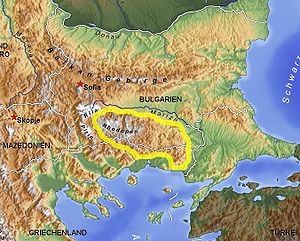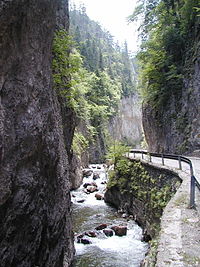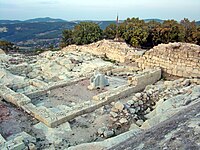Rhodope Mountains
| Rhodopes | |
|---|---|
| Bulgarian: Родопи Greek: Ροδόπη Aromanian: Rodopi Turkish: Rodoplar | |
 | |
| Highest point | |
| Peak | Golyam Perelik |
| Elevation | 2,191 m (7,188 ft) |
| Coordinates | 41°36′04″N 24°34′27″E / 41.60111°N 24.57417°E |
| Dimensions | |
| Length | 240 km (150 mi) west-east |
| Width | 100 km (62 mi) north-south |
| Area | 14,735 km2 (5,689 sq mi) |
| Geography | |
| Countries | Bulgaria and Greece |
| Geology | |
| Type of rock | granite, gneiss, marble and quartz |

The Rhodopes (
A significant part of Bulgaria's
Name and mythology
The name of the Rhodope Mountains is of Thracian origin. Rhod-ope (Род-oпа) is interpreted as the first name of a river, meaning "rusty/reddish river", where Rhod- has the same Indo-European root as the Bulgarian "руда" (ore, "ruda"), "ръжда" (rust, "rǎžda"), "риж" (red-haired, "riž"), Latin "rufus" (red), German "rot" (red), English "red", Greek ροδ- (rodh).[1][2]
In
The mountains are also associated with the mythic figure of Orpheus.[4]
In the
Geography

In
Fifteen reserves have been established in the region, some of which are under
Climate


The location of the Rhodopes in the southeastern part of the
The average annual temperature in the Eastern Rhodopes is 13 °C (55 °F), the maximum precipitation is in December, the minimum in August. In the Western Rhodopes, the temperature varies from 5 to 9 °C (41 to 48 °F) and in the summer rainfalls prevail.
The mild climate, combined with some other factors, works in favour of the development of recreation and tourist activities. The Pamporovo resort, where the microclimate permits a heavy snow cover to be preserved for a long time, is an excellent example.
Temperatures as low as −15 °C (5 °F) are common in winter, and due to this the Rhodopes are the southernmost place in the Balkans where tree species such as the
Waters
The mountains have abundant water reserves, with a dense network of mountain springs and rivers. Nearly 80% of the mountain's territory falls within the drainage of the river
Subdivision
Western Rhodopes


The Western Rhodopes are the largest (66% of the area of the Rhodopes in Bulgaria), higher, most infrastructurally developed, and most visited part of the mountains. The highest and best known peaks are located in the region (more than 10 are over 2,000 meters (6,562 ft) high) including the highest one, Golyam Perelik (2,191 meters (7,188 ft)). Among the other popular peaks are Shirokolashki Snezhnik (2,188 meters (7,178 ft)), Golyam Persenk (2,091 meters (6,860 ft)), Batashki Snezhnik (2,082 meters (6,831 ft)), Turla (1,800 meters (5,906 ft)).
Some of the deepest river gorges in the Rhodopes are located in the western parts, as well as the rock phenomenon
dams.The town of
Eastern Rhodopes
The Eastern Rhodopes are spread over a territory of about 34% of the mountains' area in Bulgaria, constituting a much lower part.
The large artificial dams
Major cities in the area are Haskovo and Kardzhali, as well as the smaller Momchilgrad, Krumovgrad, Zlatograd and Kirkovo. The Eastern Rhodopes, being significantly lower, are also more populated than the western part.
Almost every species of the European birds of prey nest in the rocks and forests of the Eastern Rhodopes including the rare black vulture and Egyptian vulture.
Southern (Greek) Rhodopes


The Southern Rhodopes are the part of the mountain range that is located in Greece. The Rhodope regional unit in the northern part of the country is named after the region. This area includes the Rodopi Mountain Range National Park.[6]

The Southern Rhodopes are characterized by numerous peaks of relatively low altitude. Their highest peak is Delimposka (1,953m) in the mountain of Frakto, near the Greek-Bulgarian border. Nowadays the Southern Rhodopes is an area almost deserted. After
In the forest of Frakto there are 300-year-old trees, more than 50 metres high, and the endangered wild goat.
In the eastern part of the region there is the well known nature reserve of
History
This section needs additional citations for verification. (December 2016) |

The Rhodopes have been inhabited since the
The first known human inhabitants in the mountains were the Thracians.[7] They built many temples, cities and fortresses. The most famous town in the area is the sacred city of Perperikon located 15 km northeast of Kardzhali. One of the most important Thracian temples was Tatul near the village of the same name. Additionally, there are archeological sites throughout the region related to the cult of Dionysus, such as the ancient Thracian city of Perperikon.

The frequent mention of the Rhodope in Ancient Greek and Latin sources indicates that the mountain had played an important role in the political and religious life of the Thracian tribes that lived on it. On the tops of the mountain there was a famous oracle, which they had visited to consult
In 2005, German scholars from the University of Heidelberg confirmed that the two rather small fragments discovered by archaeologist Nikolay Ovcharov in the Eastern Rhodopes mountains are written in the Minoan Linear A script from about 15th century BC.[9]
In the
During the 16th and 17th centuries the Ottoman authorities began a process of Islamisation of the region.
The towns and the villages in the Western Rhodopes took active part in the
The northern Rhodopes were ceded in 1878 to an autonomous province of
People

The sparsely populated area of the Rhodopes has been a place of ethnic and religious diversity for hundreds of years. Apart from the Eastern Orthodox Bulgarians and Greeks, the mountains are also home to a number of Muslim communities, including the Pomaks, that predominate in the western parts and a large concentration of Bulgarian Turks[13] and Greek Turks, particularly in the Eastern Rhodopes. The mountains are also one of the regions associated with the Sarakatsani, a nomadic Greek people who traditionally roamed between Northern Thrace and the Aegean coast.[citation needed] Aromanians, a Romance-speaking ethnic group, also live in the Rhodopes.[14] and Agupti who are a blend of Turks, Roma and Pomaks and don’t associate themselves with other Roma groups.[15]
Economy
The economy of the Rhodopes region is dominated by services, tourism, industry and agriculture.
Livestock breeding, forestry and tobacco are the most important agricultural activities. Due to the large Muslim population the number of pigs is relatively low but there are many sheep which are traditional for the Rhodopes. Tobacco is grown in the Eastern Rhodopes and forms a large part of the total national production.
The industrial sector is well-developed. One of the largest industries in the area is mining. There are around 80 mines for lead and zinc whose reserves are among the largest in Europe. They are situated mainly in central parts of the mountain and along the border with Greece as well as to the east. Kardzhali Province is rich in non-metalliferous minerals and gold. There are also small reserves of chromite and iron ore as well as significant impurities of rare metals in the lead and zinc ores. There are several flotation factories which enrich the ores before it is sent to the large lead and zinc refineries in Kardzhali and Plovdiv. The machine-building industry is developed in Smolyan, Kardzhali, Devin, Bratsigovo, Ivailovgrad and others; there is a pharmaceutical plant in Pestera. Some of the centers of textile industry include Zlatograd, Smolyan, Madan, Laki. The timber industry is developed mainly in the western parts where there are some of the most important forest massifs in the Balkan Peninsula. The Rhodopes are one of the main hydro-power generation regions of Bulgaria with a number of major hydroelectric power plants such as Batak, Peshtera, Aleko, Studen Kladenets, Kardzhali, Vacha and Thisavros and Platanovrysi in Greece.

Honour
Rodopi Peak on Livingston Island in the South Shetland Islands, Antarctica is named after the Rhodope Mountains.[citation needed]
See also
- Geography of Bulgaria
- List of mountains in Bulgaria
- List of mountains of the Balkans
- List of mountain ranges
- Mantaritza Biosphere Reserve
- Rila
- Pirin
- Balkan Mountains
- Vitosha
References
- ^ a b Dechev, Dimitar (1925). "Хемус и Родопи [Hemus and Rhodope]". Годишник на Софийския университет, Историко-филологически факултет [Yearbook of Sofia University, Faculty of History and Philology] (in Bulgarian). Vol. XXI.10. Sofia: Faculty of History and Philology, Sofia University. p. 31.
- ISBN 3-88893-031-6.
- ^ Rhodope offended the gods and was turned into a mountain in Thrace [Ov.Met.6.83].
- ^ Norman, Philip (21 September 2012). "Bulgaria: Between heaven and hell". The Independent. Retrieved 23 October 2020.
- ^ The Rilo-Rhodope massif is sometimes referred to as the Rhodope mountains alone.
- ^ "Rodopi Mountain Range National Park". www.fdor.gr.
- ^ Iliev, J. Rhodope Mountain in Thrace according to concepts of the ancient writers. – Rhodopica, 2007, 1, p. 89 ff.
- ^ D. C. Samsaris, Historical Geography of Western Thrace during the Roman Antiquity (in Greek), Thessaloniki 2005, pp. 15–33
- ^ Linear A script from the Eastern Rhodopes? (May 2005)
- ^ Иречек, К. История на българите, С., 1929, с. 248
- ^ Sir Edwin Pears, Forty Years in Constantinople, London, 1915, chapter II.
- ^ Turks in Bulgarian – Gladstone's article – Bulgarian Horrors and the Question of the East, London, 1876
- ^ "Bulgarian Turks: In the Middle".
- ^ Constantin, Marin (2014). "The ethno-cultural belongingness of Aromanians, Vlachs, Catholics, and Lipovans/Old Believers in Romania and Bulgaria (1990–2012)" (PDF). Revista Română de Sociologie. 25 (3–4): 255–285.
- .
- Asdracha, Catherine, La région des Rhodopes aux XIIIe et XIVe siècles: étude de géographie historique, Athen: Verlag der Byzantinisch-Neugriechischen Jahrbücher, 1976, p. 294.
- Evangelos A. Papathanassiou. "The Armenian Presence in and around the Rhodope Mountain in 11th C.: Rethinking over some new archaeological Finds", Περὶ Θράκης 7 (2010–2015), 59–97.In: auth.academia.edu/EvangelosPapathanassiou
